After making a dismal start to his Newcastle United career and being branded a flop by fans and pundits alike, nobody would have predicted that Joelinton would go on to become Player of the Season for 2021/22 – won previously by the likes of Kevin Keegan, Andrew Cole, Peter Beardsley, Paul Gascoigne, and Alan Shearer. One eventful night at St James’ Park saw him move from his usual position as a striker to starring in his new role in central midfield, where he has played ever since.
Bought from Hoffenheim in the summer of 2019 for a then club record of £40m, Joelinton, only 22 at the time, was seen as the ideal replacement for Salomon Rondon – even given the iconic number 9 shirt – and looked to be the answer to Newcastle’s striker problems. At the time, Newcastle only had the slight and stuttering Yoshinori Muto, Championship-standard Dwight Gayle and Andy Carroll as competition for Joelinton, but after several appearances without scoring and his confidence clearly diminishing game by game, he looked like the latest of a long list of poor signings during the Mike Ashley era. In this scout report, we will use tactical analysis to look at how he changed from a failing forward to a midfield maestro for the Magpies.
Newcastle strikers tend to score on their debut – Les Ferdinand, Papiss Cisse, Alexander Isak, even Xisco and Fabrice Pancrate – but nobody questioned Joelinton’s goal drought until after a handful of appearances. At first, many Newcastle fans were quick to jump to Joelinton’s defence by pointing out his success at Hoffenheim was due to him being used as an inside forward or number 10. Making space for teammates, joining in the second wave of attacks, and linking play was where Joelinton made his name.
At the age of 19, Joelinton secured a two-year loan to Austria’s Rapid Wien. Described by their sporting director, Andreas Muller, as a ‘powerful, athletic player, who, in the mould of a traditional striker, should bring plenty of menace in front of goal,’ Joelinton was used as exactly that: an advanced centre-forward. Over two seasons, he scored 15 goals in 41 league appearances for the Austrian Bundesliga side.
On his return to Hoffenheim and the much tougher German Bundesliga, Joelinton was instead used in a strike partnership alongside Ishak Belfodil or Andrej Kramaric. Depending on the formation, he was deployed as an inside forward when playing with three up front, or even as an attacking midfielder under then head coach Julian Nagelsmann. At Hoffenheim, Joelinton played as a lone striker only once.


So, how effective was he upon his return to Hoffenheim? In his only full season for the first team, Joelinton had a hand in 42% of goals in games he played, with 7 goals and 5 assists in 28 appearances. Dubbed a replacement for former Hoffenheim graduate Roberto Firmino, he was snapped up by Newcastle at the end of the 2018/19 season.

Lineups
Despite often adapting formations and tactics depending on the opponent, Nagelsmann always used a high pressing style of play, which suited Joelinton’s aggressive and physical approach. He would often hold the ball up, knock on, and create space for the other strikers and overlapping wing backs to run into. This was a style of play totally alien to what Bruce employed at Newcastle.
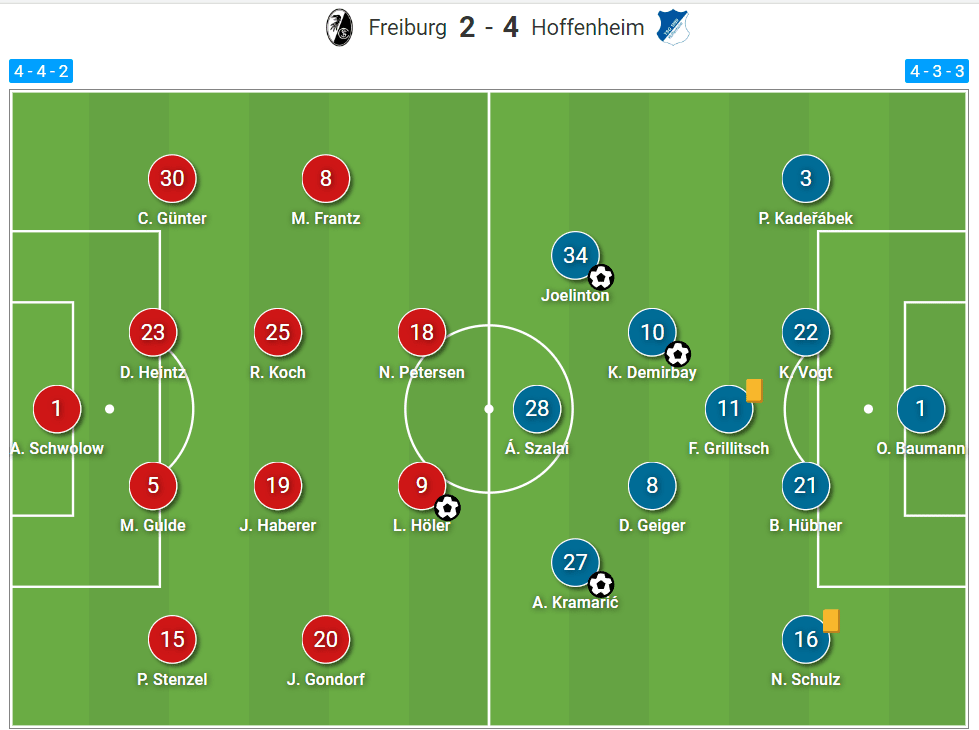
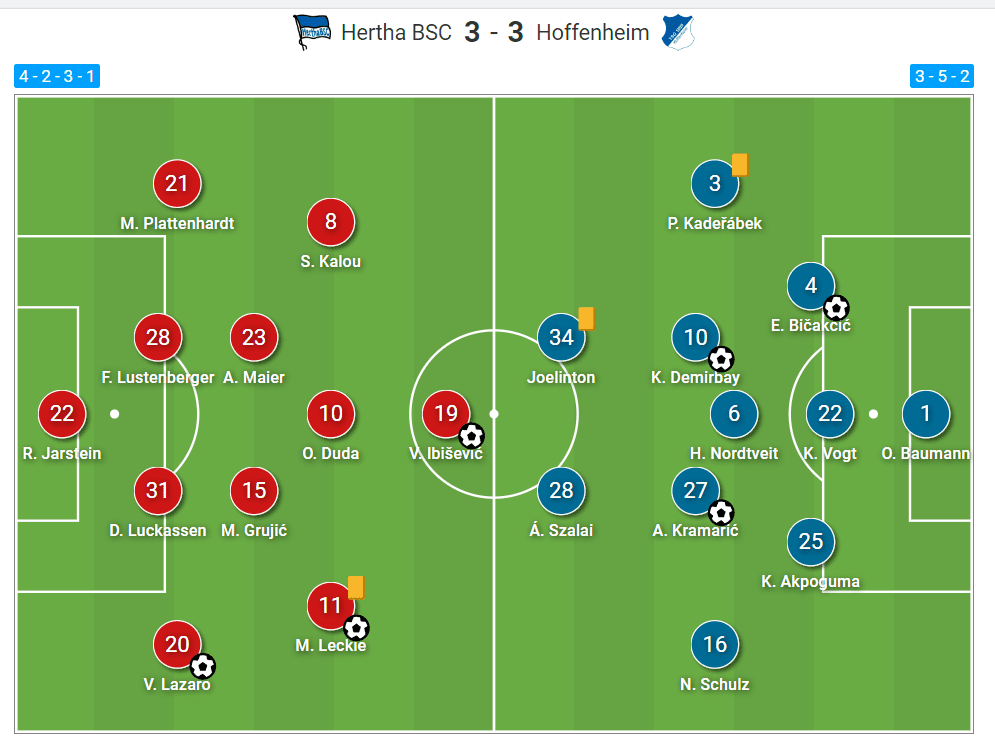
In his first season at St James’, Joelinton had to adapt to a tactic that Bruce unoriginally hijacked from Rafael Benitez’s 5-4-1 formation. This saw the players drop deep behind the ball and stand off the opposition. Bruce allowed, on average, the opposition 18 passes per press, the highest in the league.
One could ask why then owner Mike Ashley would even purchase a player so at odds with Bruce’s style, especially when Newcastle scouts visited Germany 24 times to watch Joelinton, but Ashley’s reputation for buying high potential players at low prices and selling high answers that question.
Position at Newcastle
As Bruce wanted his players to play so deeply, Joelinton often cut an isolated figure up front. Expected to win long ball after long ball in the air (derided as ‘hoofball’ or ‘Brucey ball’ by the home fans) or hold onto possession whilst waiting for support from teammates. Often, only Almiron or Saint-Maximin offered support but would start their runs from deep in the Newcastle half.
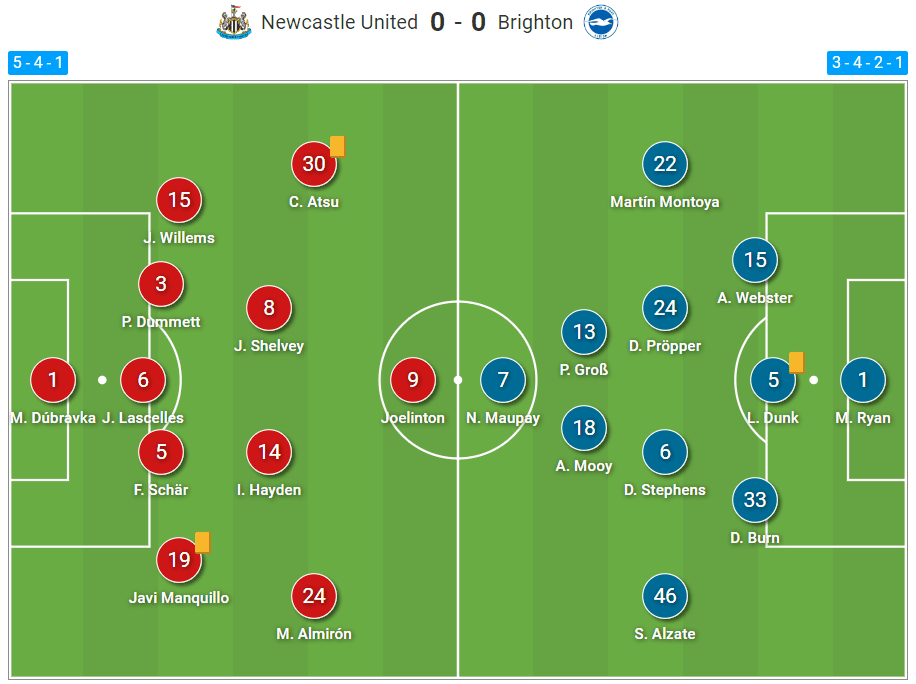
In his first season under Bruce, Joelinton was involved in nearly twice as many aerial battles as he was at Hoffenheim. At Newcastle, he won an average of 5 per game in his first season, compared to 2.3 per game when at the Bundesliga side. He also had three times as many headed shots as his season in Germany (45% of shots versus 15%).
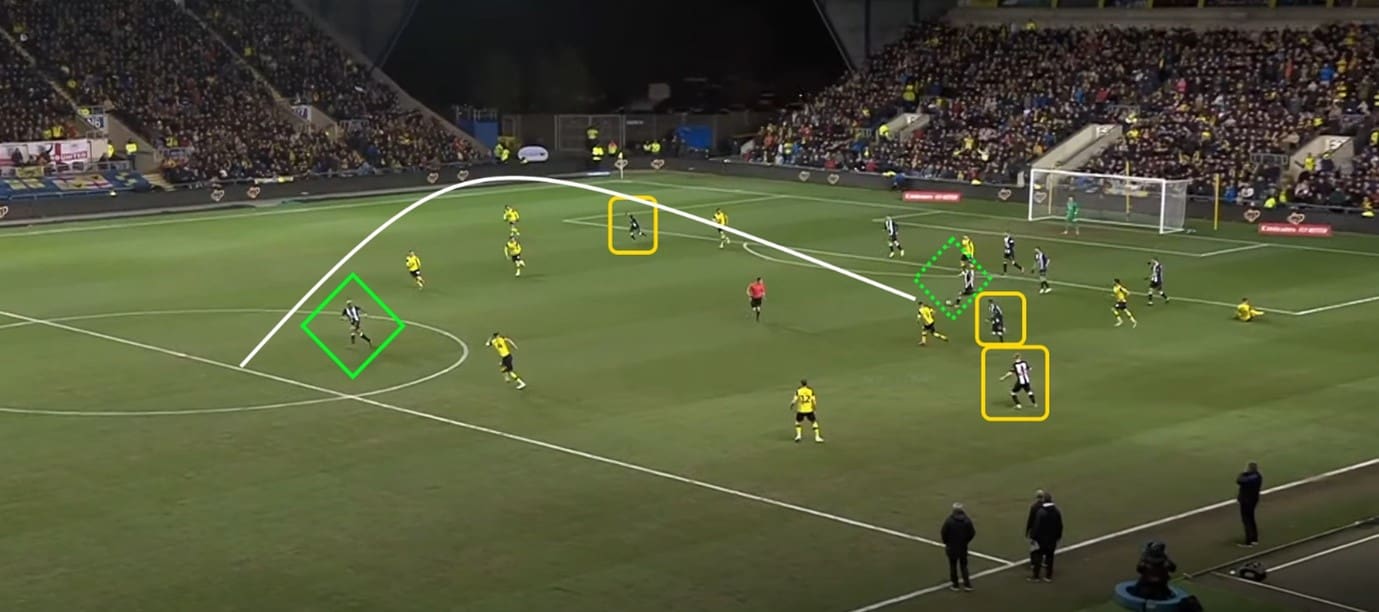
Unsurprisingly, Joelinton contributed very few goals and assists in his first season at Newcastle. Scoring just twice and providing two assists in 38 premier league games, he had a goal contribution rate of just 11%. In his second season, he didn’t fair much better, scoring four and assisting twice in 31 games, a goals/assist contribution of 19%.

This underperformance, or rather misuse of a once-promising forward, saw Joelinton come under intense scrutiny from journalists, pundits, and fans. Labelled a flop, a misfit, and ‘Steve Bruce’s worst signing ever’, he often featured in polls and lists of the Premier League’s all-time worst players. Described by Bundesliga analyst Abel Meszaros as a ‘confidence player’, it was obvious that his lack of goals, harsh criticism, and being a square peg in a round hole was all getting to him.

So what changed under Eddie Howe? November 30, 2021, at 7:39 p.m. was when Joelinton’s Newcastle career belatedly took off. Having failed to win any of their first 13 games of the 21/22 season and sitting 19th in the League, Newcastle were well aware that no team in Premier League history had ever survived relegation after failing to win any of their first 14 games.
Despite the new hope and optimism surrounding Newcastle after the recent Saudi takeover and becoming the world’s richest club as well as being buoyed by Howe’s appointment, there was a lot of tension in the air leading up to the 14th game of the season.
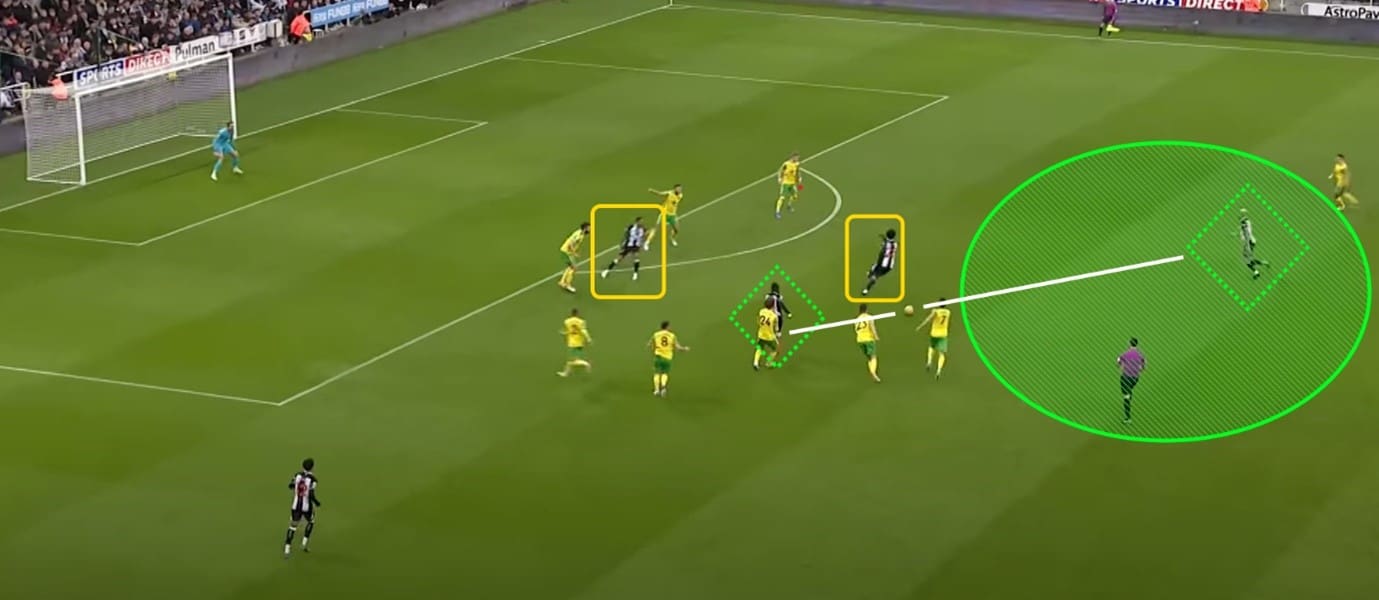
After nine minutes, Newcastle’s Ciaran Clark fouled Teemu Pukki outside the box and was sent off. Howe immediately substituted Ryan Fraser for Federico Fernandez, who slotted into Clark’s place, and Joelinton moved to the centre of the park. Saint-Maximin was moved up the field to play alongside Wilson in a 4-3-2 formation.
Joelinton immediately looked more at home, finding himself in space within minutes of the change to shoot just over the bar from outside the box. After Wilson scored for Newcastle from the spot, Newcastle faced more and more pressure as the night wore on, forcing Joelinton to constantly press and harry the opposition from his own half.
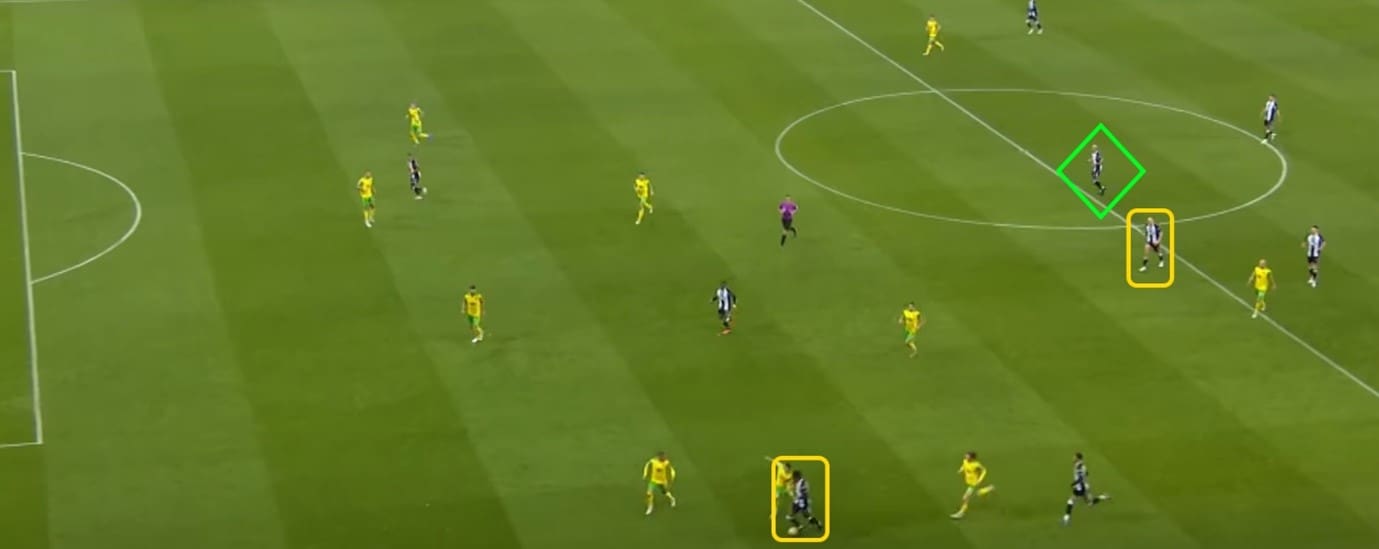
During set pieces, Joelinton was always deep in defence, marking players and chasing down loose balls and would pressure the opposition relentlessly. In possession, he always made himself available to teammates and often found space to exploit between the defence and the forwards.
For Newcastle, he had the second most touches (51) behind playmaker Jonjo Shelvey, won the most aerial duals (3), was the most fouled player alongside Almiron (2) and had the same number of shots on target as Callum Wilson. Joelinton’s contribution helped Newcastle cling on for a 1-1 draw, despite being down to 10 men for 81 minutes. These stats are by no means overwhelming, but he showed improvement enough that night to be named Alan Shearer’s Man of the Match.
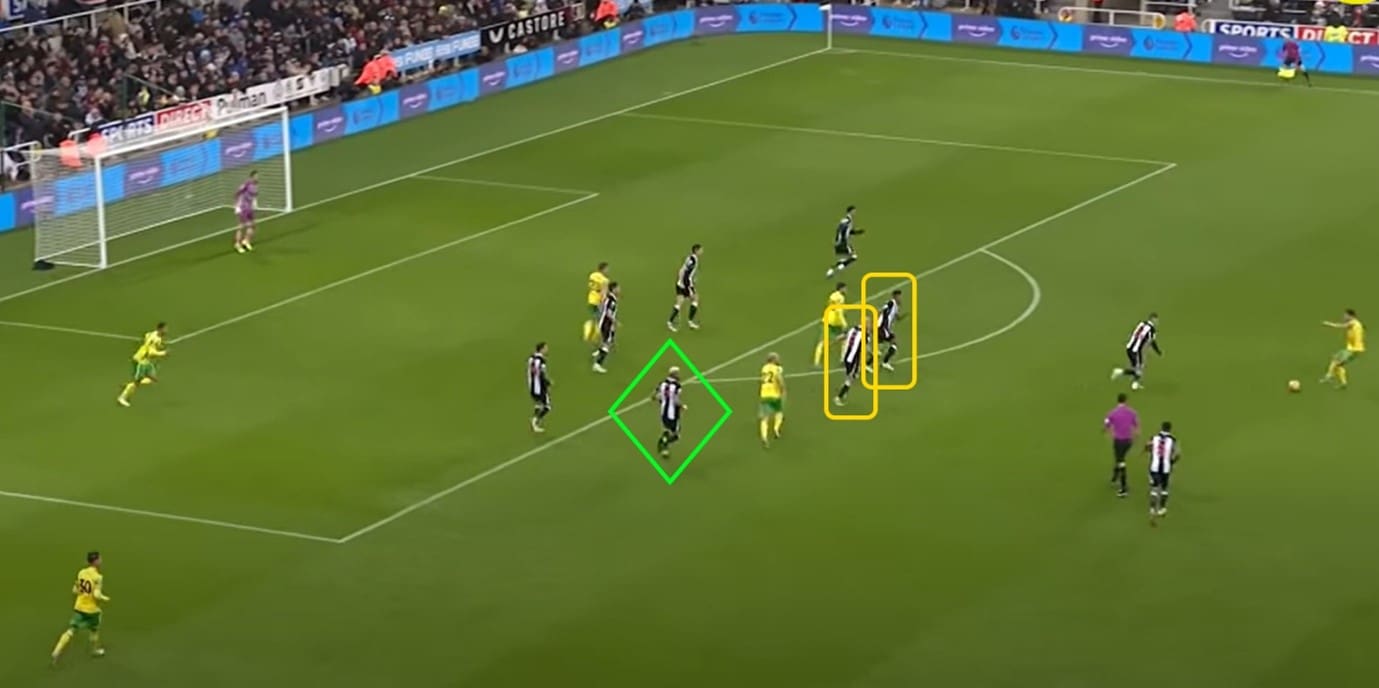
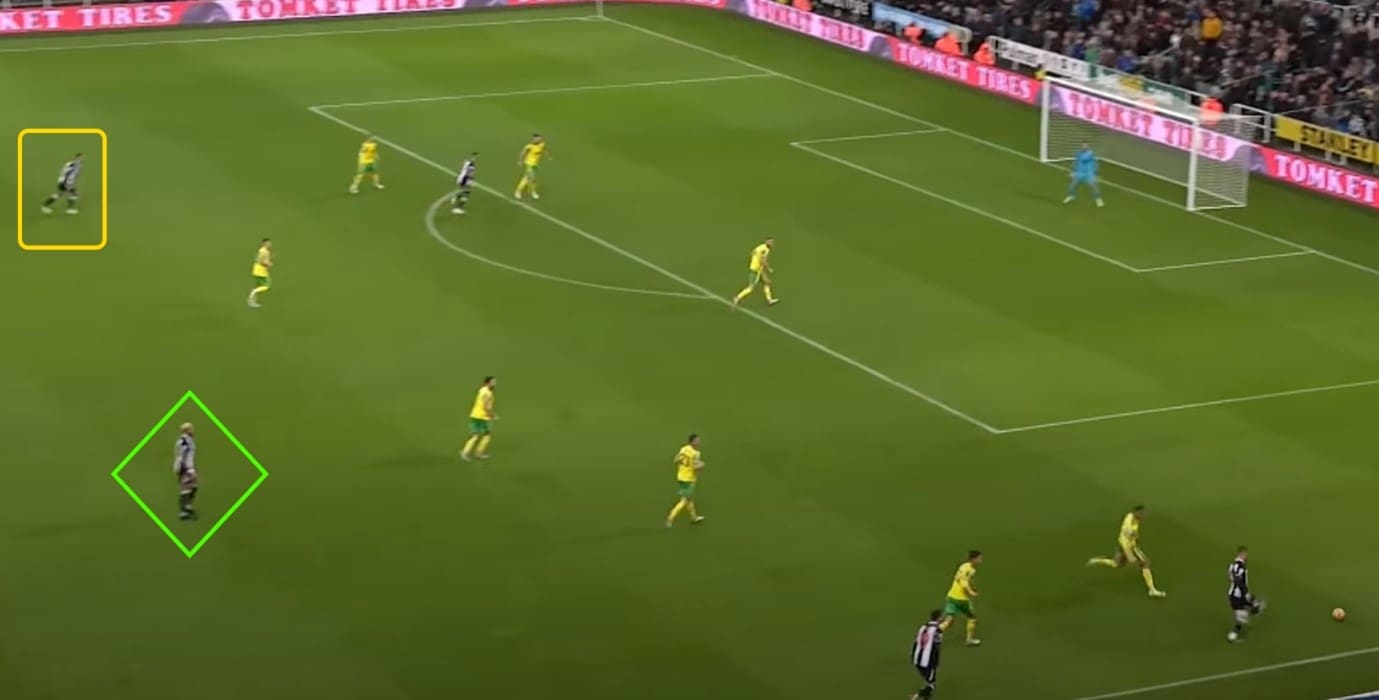
Joelinton would go on to win Man of the Match twice more that season, including in 1-1 a home draw against Manchester United where he helped keep Ronaldo et al quiet. In that game, he had the most touches, won the most tackles, won most ball recoveries and aerial duals, completed the most passes, and was second in interceptions (3). It was a performance that led to Sky Sports commentator Patrick Davidson opening his post-match interview with Joelinton with, “Can I be completely honest? I didn’t realise you were that good!”.
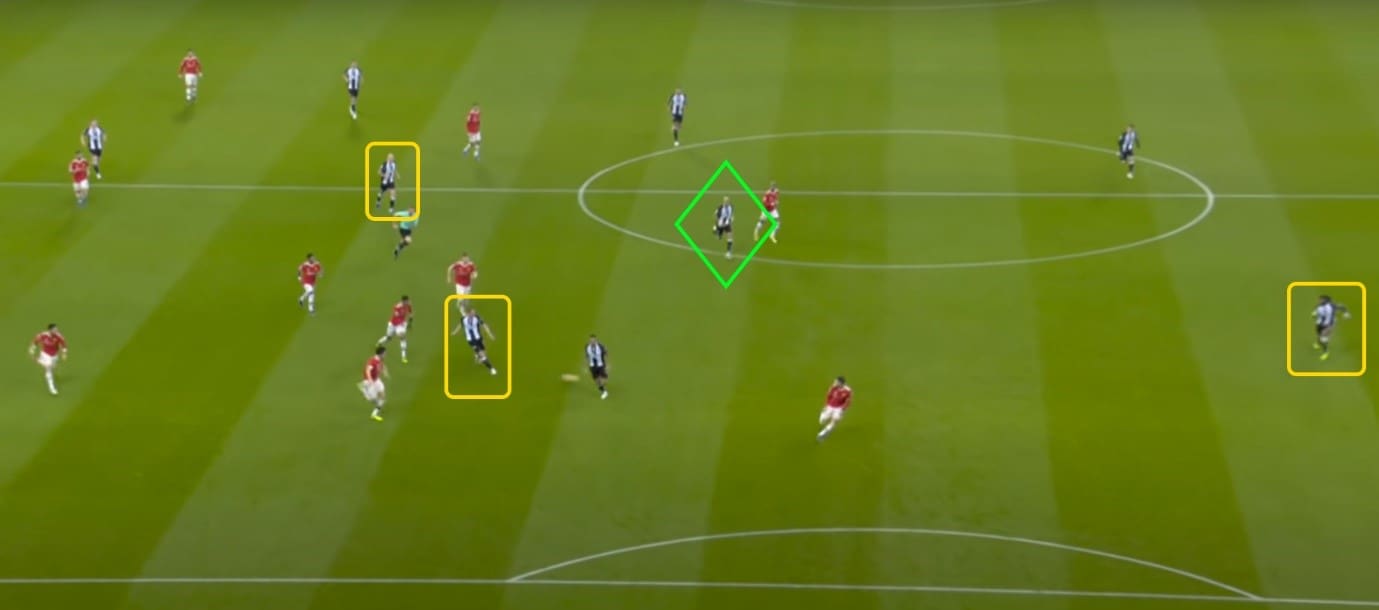
Vs. Man Utd: staying deep as part of a midfield 5 in the build-up to Saint-Maximin’s goal
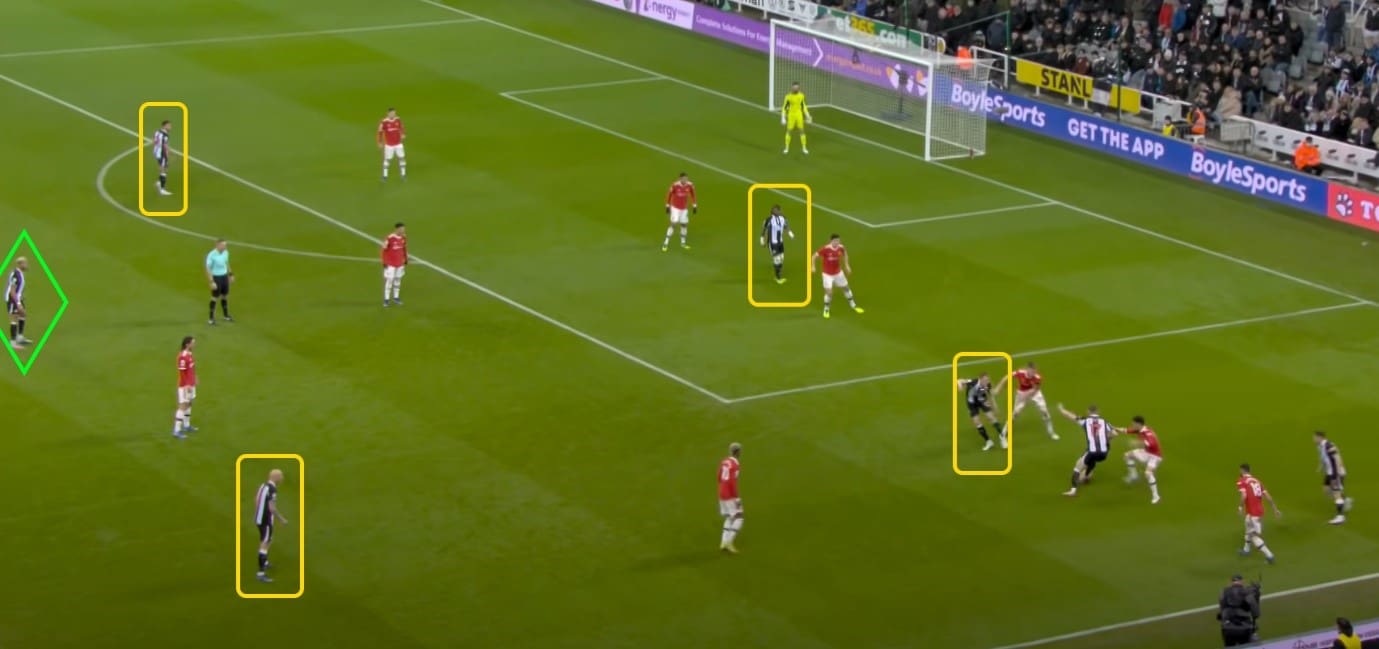
Since the 1-1 draw with Norwich, Joelinton has made the midfield position his own and has remained there ever since. In the 2021/22 season, he improved on the previous season in tackles per game (2.3, making only 1.5 in the previous season), interceptions (1.4 per game, 0.4 in the previous season), passes per game (32.8 compared to the previous year’s 26.3), ground duels won (5.4 per game, 4.7 in the season before), and only scored lower in shots per game (1.5 per game, 2 per game in the previous season) due to moving from centre forward to central midfield.
Joelinton was always known for his work rate, tenacity, and pressing before joining Newcastle. Under Howe, it looks like we’ll be seeing more of the same. So far this season, in five Premier League games, he has won Man of the Match once, provided one assist, and has a successful pass rate of 82.2%. His stats in Newcastle’s 2-1 loss to Liverpool a few weeks back were impressive, with the most tackles (5), 10 ball recoveries, 3 interceptions, 3 clearances, 27 passes and 64 touches, winning 5 aerial and 7 ground duels.
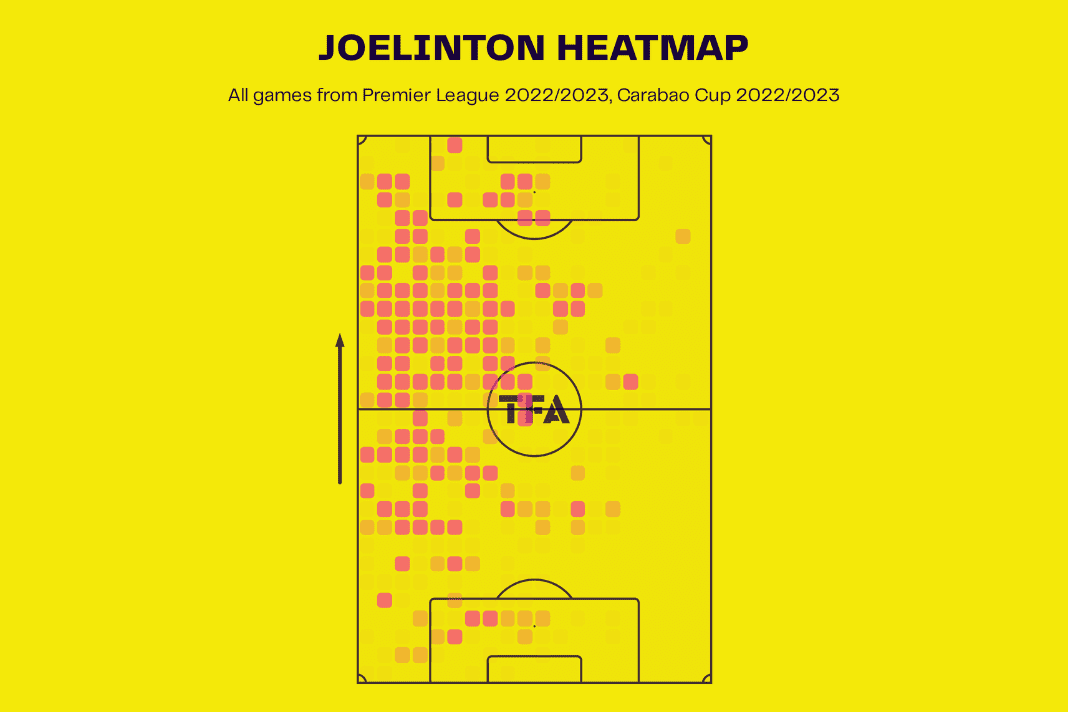
As you can see from this season’s heat map, Joelinton is very active on the left side of the pitch and spends around two-thirds of his time in the opponent’s half. This contrasts wildly from his first season at Newcastle where he was predominantly in the centre of the pitch and never really dropped deep to collect the ball or support teammates, rarely crossing the halfway line.
Joelinton’s reinvention at Newcastle is much closer to how he was used at Hoffenheim in linking play between defence and attack, dropping deep to win duels and interceptions, finding space to support teammates, and putting pressure on the opposition. Howe mostly uses a 4-3-3 or 4-5-1 formation with Joelinton on the left of a midfield three, performing as an attack-minded ball winning midfielder.
Conclusion
Joelinton’s transformation under Howe has been nothing short of remarkable, as shown in this analysis. Didi Hamann, erstwhile midfielder of Newcastle and Liverpool, even urged the Reds to buy Joelinton this summer:
“I think he’s someone who’s technically gifted, who’s a big lad… I think that’s the type of player they miss.”
Joelinton has gone on to become a cult hero amongst Newcastle fans. His face can be seen all over Hawaiian-style shirts and he has two flags dedicated to him in the Gallowgate End of St James’ Park. One fan was even invited to his house after having a picture of Joelinton celebrating a goal tattooed onto his stomach. Once seen as a failing forward, Joelinton has, through hard work, grit, and determination cemented himself a place in the Newcastle midfield and fan folklore.





Comments